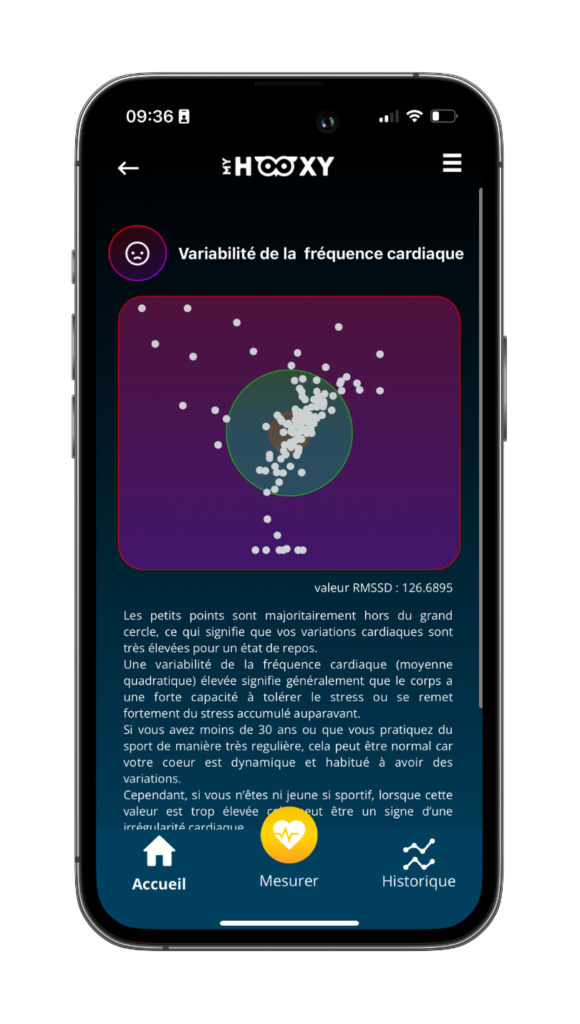
What is heart rate variability ?
Would you like to know more about heart rate variability?
Heart rate variability (HRV) is a measure of the activity of the autonomic nervous system, a concept explained in this article. Heart rate variability is considered one of the best indicators of the human body’s physical and sporting capabilities.
Heart rate variability :
Heart rate variability corresponds to the variations in heartbeats. It’s a measure of the time interval between each beat. Although heart rate tells us how many beats the heart makes per minute, it doesn’t tell us exactly how long each beat is. The heart doesn’t work like a metronome: at 60 beats per minute, it beats every second. In fact, the intervals between beats are not as precise.
(To calculate heart rate variability, we measure the interval between each beat, noted R. To calculate HRV, MyHooxy uses the RMSSD formula. This formula corresponds to the root mean square of the intervals between beats).

The autonomic nervous system in relation to heart rate variability:
As we have seen, the autonomic nervous system is made up of two parts: the parasympathetic system and the sympathetic system. The former corresponds to relaxation, rest and digestion, while the latter refers to fight and flight.
Since the autonomic nervous system unconsciously regulates the functioning of the body’s organs and cells, it’s obvious that the heart is affected by its movements and activities. It is therefore the alternation between sympathetic and parasympathetic system activation that causes a slight variability in the heartbeat. One might think that these opposing actions to which our heart is subjected could be too brutal, but quite the opposite is true. In fact, heart rate variability is the sign of a balance between the solicitations of the sympathetic and parasympathetic systems. It’s proof that these two complementary systems both act to constantly regulate the body’s functioning. The two parts of the autonomic nervous system must remain in balance, and one must not override the other.
How to interpret your heart rate variability:
Now that you’ve understood how heart rate variability works, you’re probably wondering how to interpret your results?
Since the autonomic nervous system unconsciously regulates the functioning of the body’s organs and cells, it’s obvious that the heart is affected by its movements and activities. It is therefore the alternation between sympathetic and parasympathetic system activation that causes a slight variability in the heartbeat. One might think that these opposing actions to which our heart is subjected could be too brutal, but quite the opposite is true. In fact, heart rate variability is the sign of a balance between the solicitations of the sympathetic and parasympathetic systems. It’s proof that these two complementary systems both act to constantly regulate the body’s functioning. The two parts of the autonomic nervous system must remain in balance, and one must not override the other.
First and foremost, frequency variability is not a fixed, absolute measure for all individuals. In fact, it can vary significantly from one person to another. Generally speaking, high-level athletes have a much higher heart rate variability than most people. Men also tend to have a higher HRV than women.
This is normal and corresponds to the aging process of the body and consequently of the autonomic nervous system. Generally speaking, a person in his twenties will have a HRV of around 60 to 105 milliseconds, while an elderly person will measure his HRV at around 40 to 70 milliseconds. With heart rate variability, there’s no point in aiming for the heights, just finding the measurement that suits you best in practice.
How to influence heart rate variability:
Generally speaking, adopting a healthy lifestyle helps to improve heart rate variability. It’s important to bear in mind that the factor with the greatest influence on HRV is regularity, which is surprising for a measurement characterized by its irregularity.
First and foremost, good hydration will improve your blood circulation, enabling the body to be constantly nourished. It’s considered good practice to consume 30ml of water per kilogram for regular hydration. Secondly, a healthy, regular diet improves CFV; snacking between meals causes irregularity, which has a negative effect on CFV. Lastly, the care and regularity you give to your sleep, in terms of quantity but above all quality, will have a positive effect on your CFV.
It’s also worth remembering that excessive alcohol consumption can have a negative impact on your FCV for up to 5 days. Daily alcohol consumption should therefore be avoided if you wish to improve your VFC.
And what about cardiac coherence?
We know that heart rate and HRV are affected by emotional state. As HRV is the result of autonomic nervous system activity, it’s only natural that a well-balanced autonomic nervous system should have a positive effect on HRV.
By practicing cardiac coherence on a daily basis, for example by following the 3-5-6 method explained in this article, you’ll quickly see positive results. On the one hand, this will enable you to optimize the functioning of your heart, and on the other, it will enable your body to better manage stress in all kinds of situations.
By using MyHooxy for your cardiac coherence practice, you’ll be able to keep a record of your results, giving you a retrospective look at your progress. Our connected oximeter gives you ultra-precise results, including an exact measurement of your CFV, so you can monitor your progress in real time. Our comprehensive cardiac coherence exercises can be adapted to your profile and needs. Don’t wait any longer to take care of yourself, your health and your well-being.